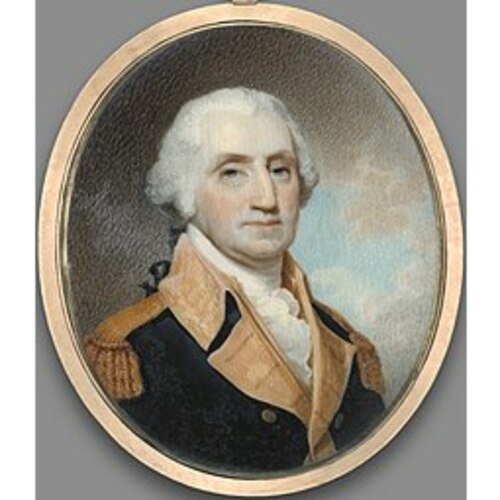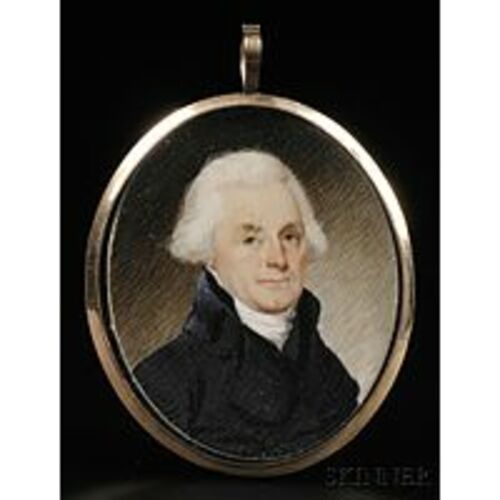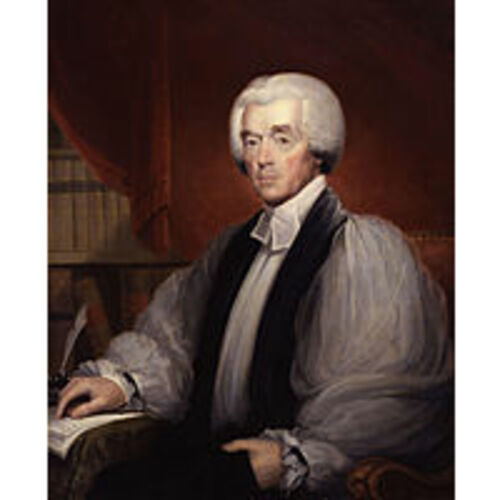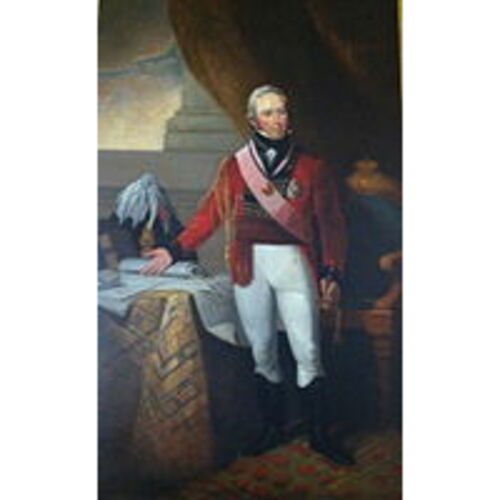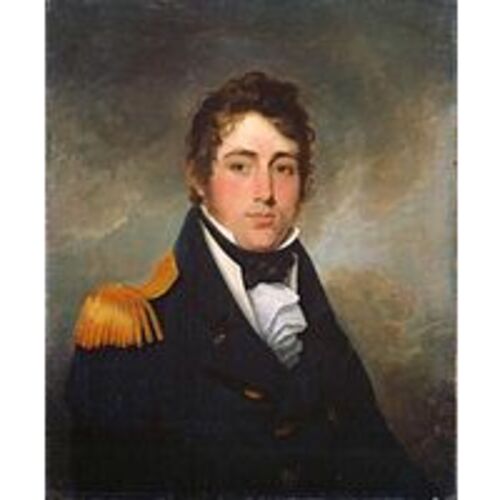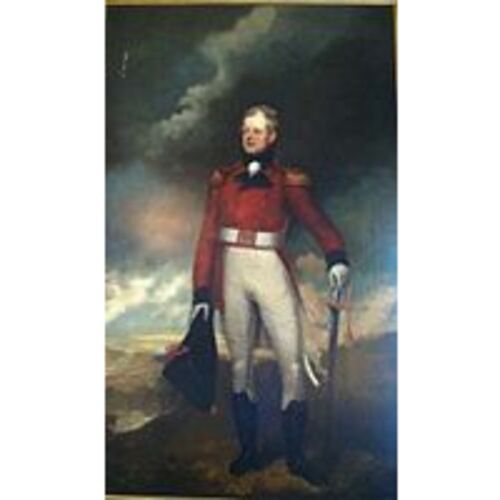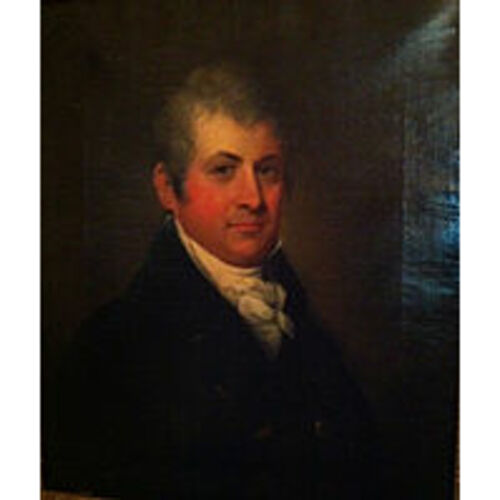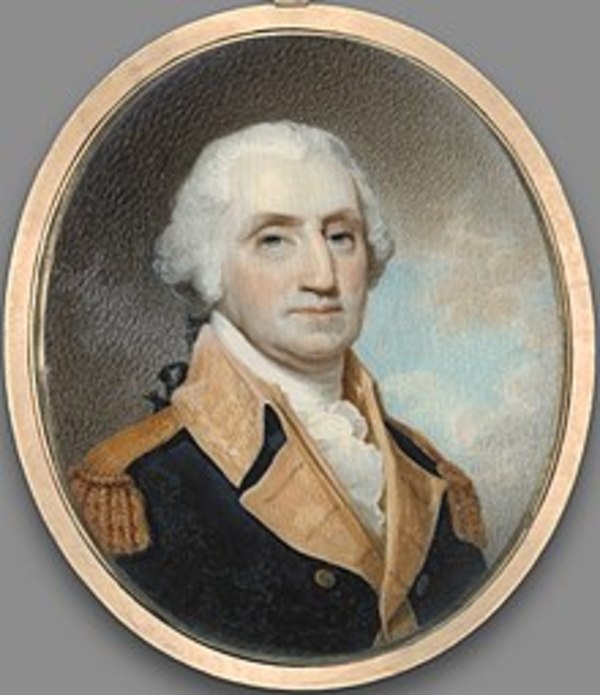
Source: Courtesy of Wikimedia Commons
FIELD, ROBERT, painter; b. c. 1769, probably in London, England; d. 9 Aug. 1819 in Kingston, Jamaica.
Although the details of Robert Field’s early career in England are obscure, it is known that he received his early training at the Royal Academy schools, London, in 1790. In 1794 he moved to the United States as part of the influx of British artists and craftsmen enticed by the prosperity of the new republic. After settling briefly in Baltimore, Md, he took up residence in the nation’s capital, Philadelphia, Pa. There he immediately joined a group of artists led by Charles Willson Peale, the noted painter and naturalist, in establishing the Columbianum, or American Academy of the Fine Arts, an organization whose plan, according to Field, was “the most enlarged, liberal and grand of any in the world.” When American-born artists objected to the academy’s authoritarian, quasi-monarchical structure – George Washington was to play a role analogous to that of George III as the first patron of the organization, and “visitors” were to travel from city to city judging which individuals were to be admitted to membership – Field and seven other English expatriates founded the rival Columbianum, or National College of Painting, Sculpture, Architecture and Engraving. This body collapsed within a few months, but the American Academy continued in operation until it was superseded by the Pennsylvania Academy of the Fine Arts in 1805.
Field spent 14 years in the United States, working as a miniature painter in Baltimore, Philadelphia, Washington, and Boston; during this period he produced miniatures of George and Martha Washington, Thomas Jefferson, and a wide range of people prominent in the social, economic, and political life of American society. In May 1808 he left the United States for Halifax, N.S., a city that was enjoying unprecedented prosperity because of its position as a base for British naval operations. Shortly after his arrival in Halifax, he set up his studio in Alexander Morrison’s bookshop, and in a newspaper advertisement he announced his intention “to exercise his profession, as portrait painter, in oil and water-colours, and in miniature.” In the years that followed he continued to produce miniatures, but he also painted more than 50 oil portraits of government officials, military officers, merchants, and assorted members of the Halifax “gentility”; among his subjects were Bishop Charles Inglis, former lieutenant governor Sir John Wentworth, Sir George Prevost, Sir John Coape Sherbrooke*, and Sir Alexander Forrester Inglis Cochrane, vice-admiral in the Royal Navy (whose portrait was shown at the Royal Academy exhibition in London in 1810). In addition, Field was an important figure in Halifax social circles: he was an honorary member of the Charitable Irish Society, and in 1812 and 1813 he served as an officer of St John’s Masonic Lodge No.211.
In a few years Field depleted the potential market for oil portraits in Halifax, and early in 1816 he moved to Jamaica, settling first in Montego Bay and then in Kingston. He died on 9 Aug. 1819, apparently of yellow fever, and was buried in an unmarked grave in the old “West Ground” cemetery, now called the Strangers’ Burial Ground, near the Kingston parish church.
Generally recognized as one of America’s leading miniaturists, Field was probably the most professionally trained painter to settle in Canada at the beginning of the 19th century. Working in the conventional neo-classic portrait style of Henry Raeburn and Gilbert Stuart, he showed little stylistic variation in his works. None the less, the oil portraits painted during the Halifax stage of his career stand as a striking illustration of patronage of the arts in colonial Canada.
Pa., Hist. Soc. (Philadelphia), Academy of Fine Arts, minutes and papers, 1794–1830; F. J. Dreer coll., painters and engravers. PANS, MG 20, 66; MG 100, 141, no.10. Notes on American artists, 1754–1820, copied from advertisements appearing in the newspapers of the day; to which is added a list of portraits and sculpture in the possession of the New-York Historical Society, comp. William Kelby (New York, 1922; repr. 1970). Acadian Recorder, 2 Jan., 25 Nov. 1815; 31 Aug. 1816; 11 Sept. 1819. British Colonist (Halifax), 3 Oct. 1848. Kingston Chronicle and City Advertiser (Kingston, Jamaica), 18 March, 11 Aug. 1819. Nova Scotia Royal Gazette, 7 June 1808, 14 Sept. 1814. Art Gallery of N.S., [Robert Field, 1769–1819]; an exhibition organized by the Art Gallery of Nova Scotia, Halifax, October 5 to November 27, 1978 (Halifax, 1978). Mantle Fielding, Dictionary of American painters, sculptors, and engravers; with an addendum containing additional material on the original entries, comp. J. F. Carr (New York, 1965). J. R. Harper, Early painters and engravers in Canada ([Toronto], 1970). The New-York Historical Society’s dictionary of artists in America, 1564–1860, comp. G. C. Groce and D. H. Wallace (New Haven, Conn., and London, 1957). J. C. Smith, British mezzotinto portraits; being a descriptive catalogue of these engravings from the introduction of the art to the early part of the present century . . . (4 pts. in 5v., London, [1878–84]). D. M. Stauffer and Mantle Fielding, American engravers upon copper and steel . . . (3v., New York and Philadelphia, 1907–17; repr. New York, 1964). H. B. Wehle and Theodore Bolton, American miniatures, 1730–1850 . . . & a biographical dictionary of the artists (Garden City, N.Y., 1927; repr. New York, 1970). Theodore Bolton, Early American portrait painters in miniature (New York, 1921). William Dunlap, A history of the rise and progress of the arts of design in the United States (2v., New York, 1834; repub., ed. Rita Weiss and intro. J. T. Flexner, 2v. in 3, 1969). Harry Piers, Robert Field, portrait painter in oils, miniature and water-colours and engraver (New York, 1927). C. C. Sellers, Charles Willson Peale (New York, 1969). Frank Cundall, “More about Robert Field,” Connoisseur (London), 77 (January–April 1927): 187. C. R. Grundy, “Robert Field, an Anglo-American artist,” Connoisseur, 76 (September-December 1926): 195–98. Barry Lord, “Portraits of a young hero: two versions of Robert Field’s ‘Portrait of Lieutenant Provo William Parry Wallis,’” National Gallery of Canada, Bull. (Ottawa), 20 (1972): 13–21. Harry Piers, “Artists in Nova Scotia,” N.S. Hist Soc., Coll., 18 (1914): 112–19. G. C. Williamson, “Robert Field, American miniature painter,” Connoisseur, 79 (September–December 1927): 50–51.
Cite This Article
Sandra Paikowsky, “FIELD, ROBERT,” in Dictionary of Canadian Biography, vol. 5, University of Toronto/Université Laval, 2003–, accessed April 13, 2025, https://www.biographi.ca/en/bio/field_robert_5E.html.
The citation above shows the format for footnotes and endnotes according to the Chicago manual of style (16th edition). Information to be used in other citation formats:
| Permalink: | https://www.biographi.ca/en/bio/field_robert_5E.html |
| Author of Article: | Sandra Paikowsky |
| Title of Article: | FIELD, ROBERT |
| Publication Name: | Dictionary of Canadian Biography, vol. 5 |
| Publisher: | University of Toronto/Université Laval |
| Year of revision: | 1983 |
| Access Date: | April 13, 2025 |


